Prelude VII ... Ce qu'a vu le vent d'Ouest, Claude Debussy
José Rodríguez Alvira
The title of this Prelude translates to What the west wind saw.
The wind
The prelude begins with fast arpeggios of a dominant D seventh chord in first inversion (the wind?). The bass will remain as a pedal tone until measure 25.

Paavali Jumppanen, piano
Isabella Stewart Gardner Museum
Creative Commons Attribution-NonCommercial-NoDerivs 4.0
What the wind saw
In measure 3, notes are added in beats 2 and 4. The first is an E flat that we can interpret as the minor ninth of the dominant chord. Debussy adds additional notes on the fourth beat. These notes will serve to generate all the prelude's thematic material (What the wind saw?), and they suggest a dominant A-flat chord. We conclude that there are two overlapping chords (polychord).
These dominant chords (D and A-flat) share the same tritone: F# - C and C - Gb. Also, they are a tritone away from each other. In jazz theory, we relate these chords to the concept of tritone substitution. In this case, they are used simultaneously.
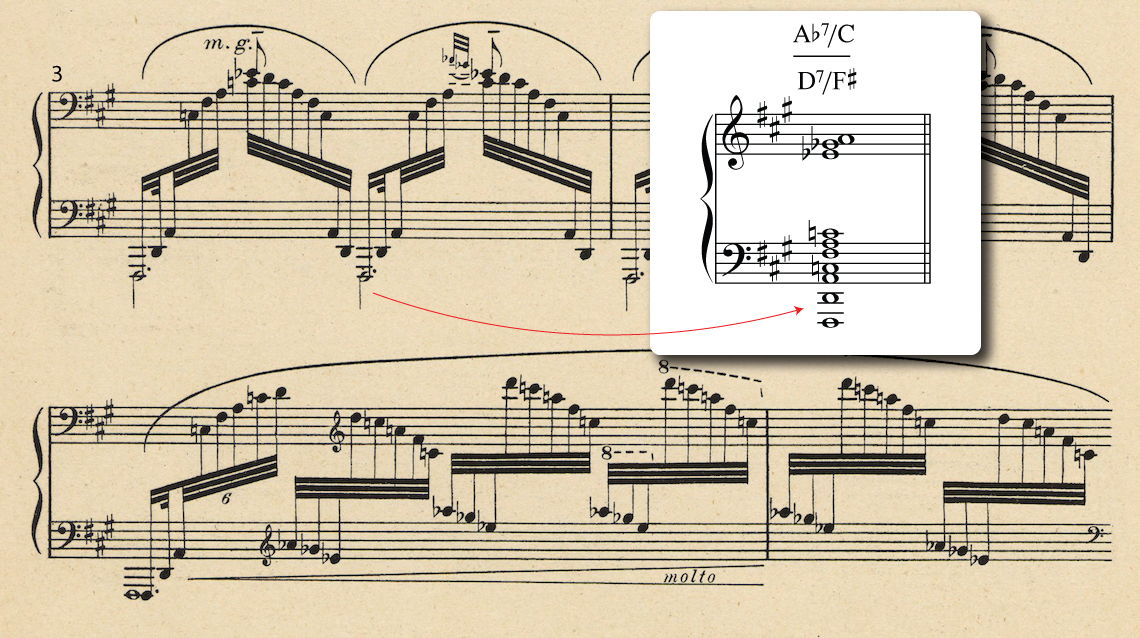
Paavali Jumppanen, piano
Isabella Stewart Gardner Museum
Creative Commons Attribution-NonCommercial-NoDerivs 4.0
In measures 7 to 9, we find a series of major chords.
- We again see the tritone relationship between the E-flat major and A major chords.
- The upper voice of the chords is the first melodic development of the notes of the previous passage.
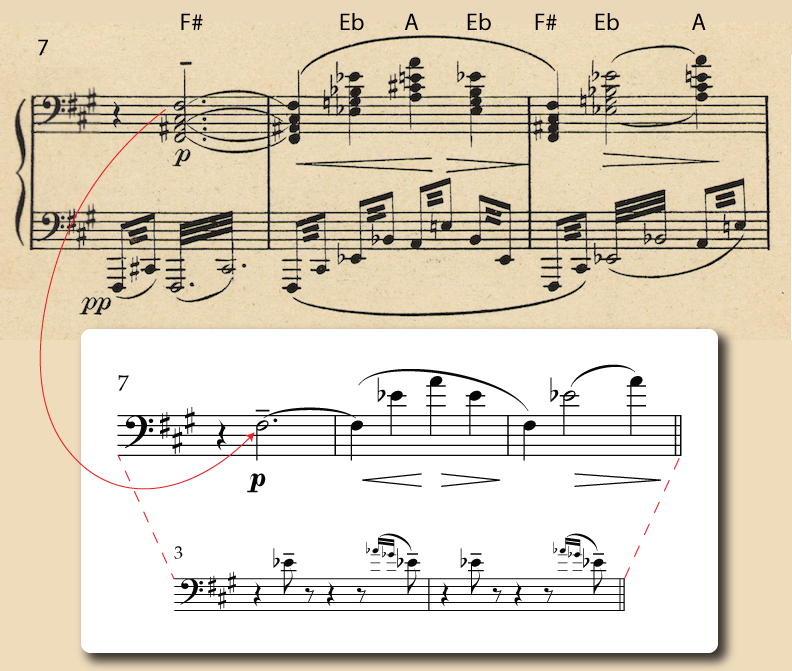
Paavali Jumppanen, piano
Isabella Stewart Gardner Museum
Creative Commons Attribution-NonCommercial-NoDerivs 4.0
In bars 10-14, Debussy uses a whole tone scale over the F# (A) pedal tone now with an added G natural.
- Note the clash between the pedal tone's F# and the F natural of the scale.
- The previous passage's long melodic notes are developed a bit more (B) using sixteenth notes that give some movement.
- The melody is doubled a major second below.
- The tritone relationship reappears between the D# and the A.
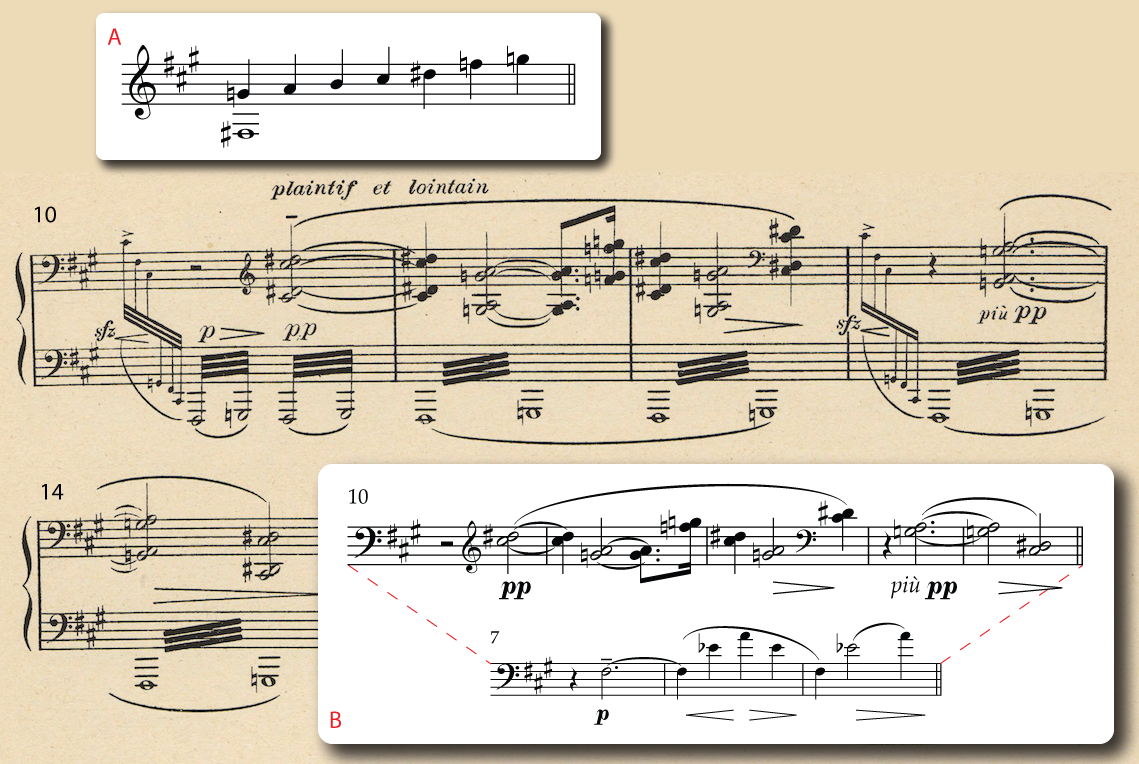
Paavali Jumppanen, piano
Isabella Stewart Gardner Museum
Creative Commons Attribution-NonCommercial-NoDerivs 4.0
In bars 15 and 16, the thematic material develops on the bass.
- Sixteenth notes turn into 32nd note (A).
- A series of major triads with ascending chromatic movement accompany the bass (B).
- Measures 17 and 18 repeats the process with the melodic line doubled in four octaves, and the chords an octave higher (C).
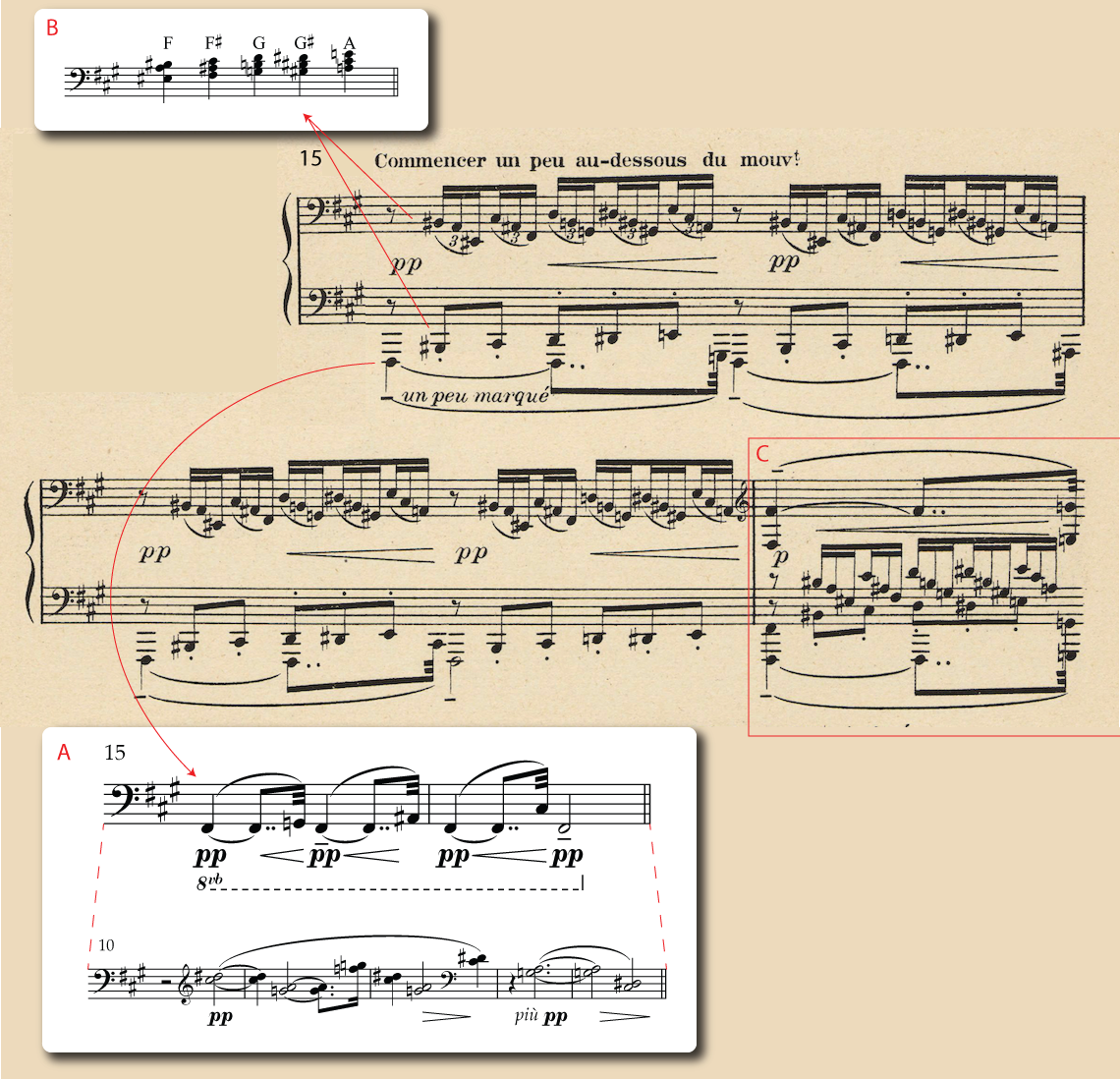
Paavali Jumppanen, piano
Isabella Stewart Gardner Museum
Creative Commons Attribution-NonCommercial-NoDerivs 4.0
Measures 19 and 20 are based on the whole-tone or hexatonic scale (an A-flat is missing from the score):
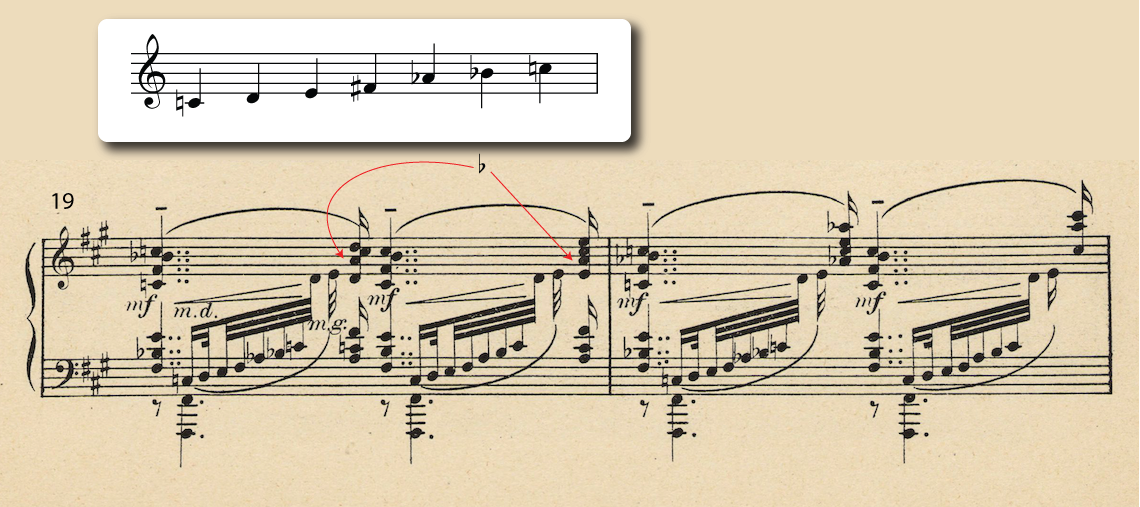
Paavali Jumppanen, piano
Isabella Stewart Gardner Museum
Creative Commons Attribution-NonCommercial-NoDerivs 4.0
Measures 21 to 24
- A series of dominant seventh chords in the third inversion harmonize the thematic material over the persistent F sharp pedal tone.
- The upper melodic line remains within the red hexatonic scale and reaches its most significant development at measure 21 and 22.
- There are few notes in measure 21 and the first two beats of 22 that are not part of the red scale.
- In the last beats of bar 22, Debussy uses the blue hexatonic for the upper voices and the red for the bass.
- Measures 23 and 24 exclusively use the red hexatonic scale.
- The key signature disappears at measure 23.
- An ostinato with the notes C and D is established from measure 23 and will serve as the basis for the next measures.
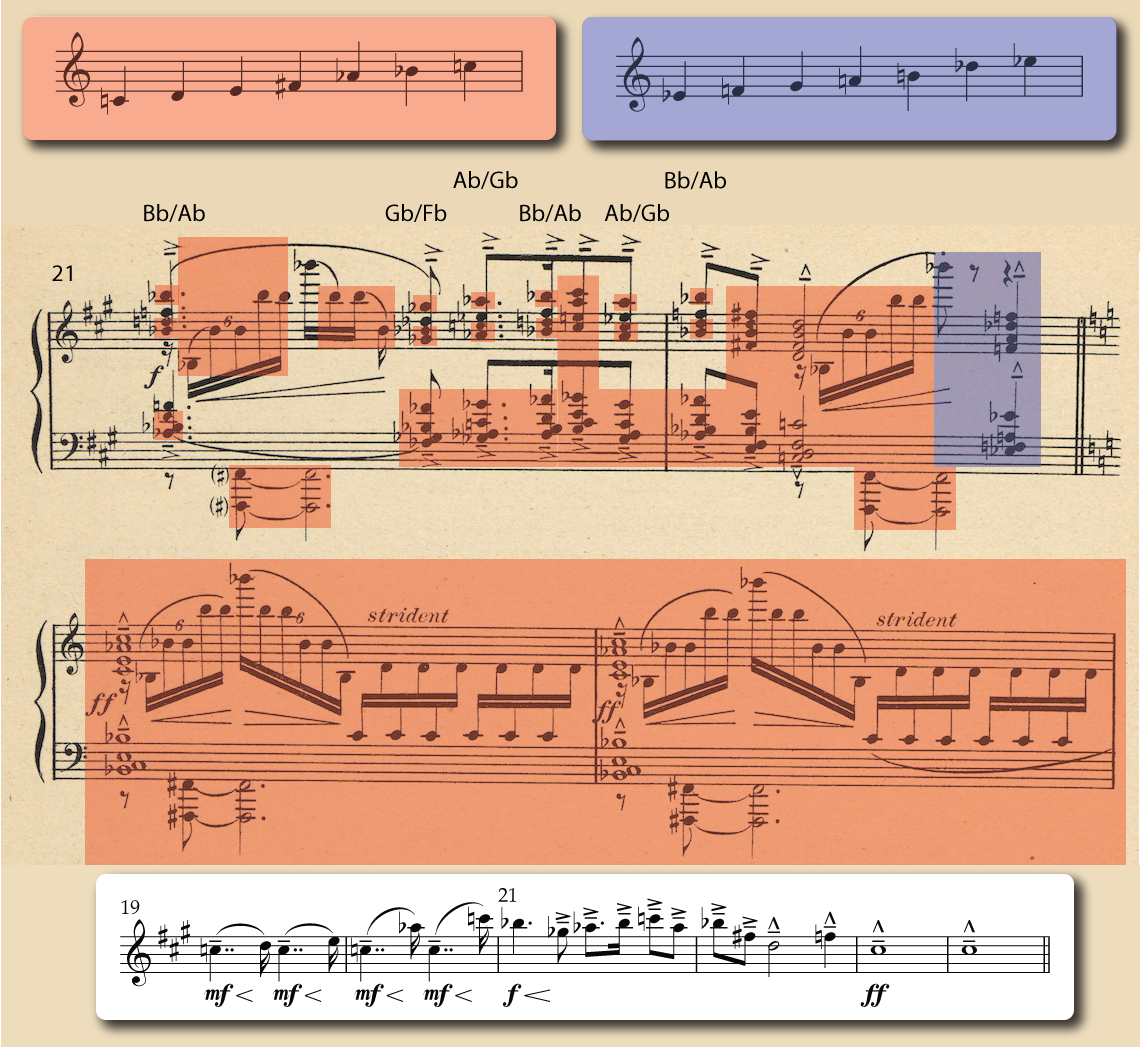
Paavali Jumppanen, piano
Isabella Stewart Gardner Museum
Creative Commons Attribution-NonCommercial-NoDerivs 4.0
The thematic material develops over the ostinato of bar 23.
- The following image shows its relationship with the preceding measures.
- At bar 30, the ostinato moves chromatically.
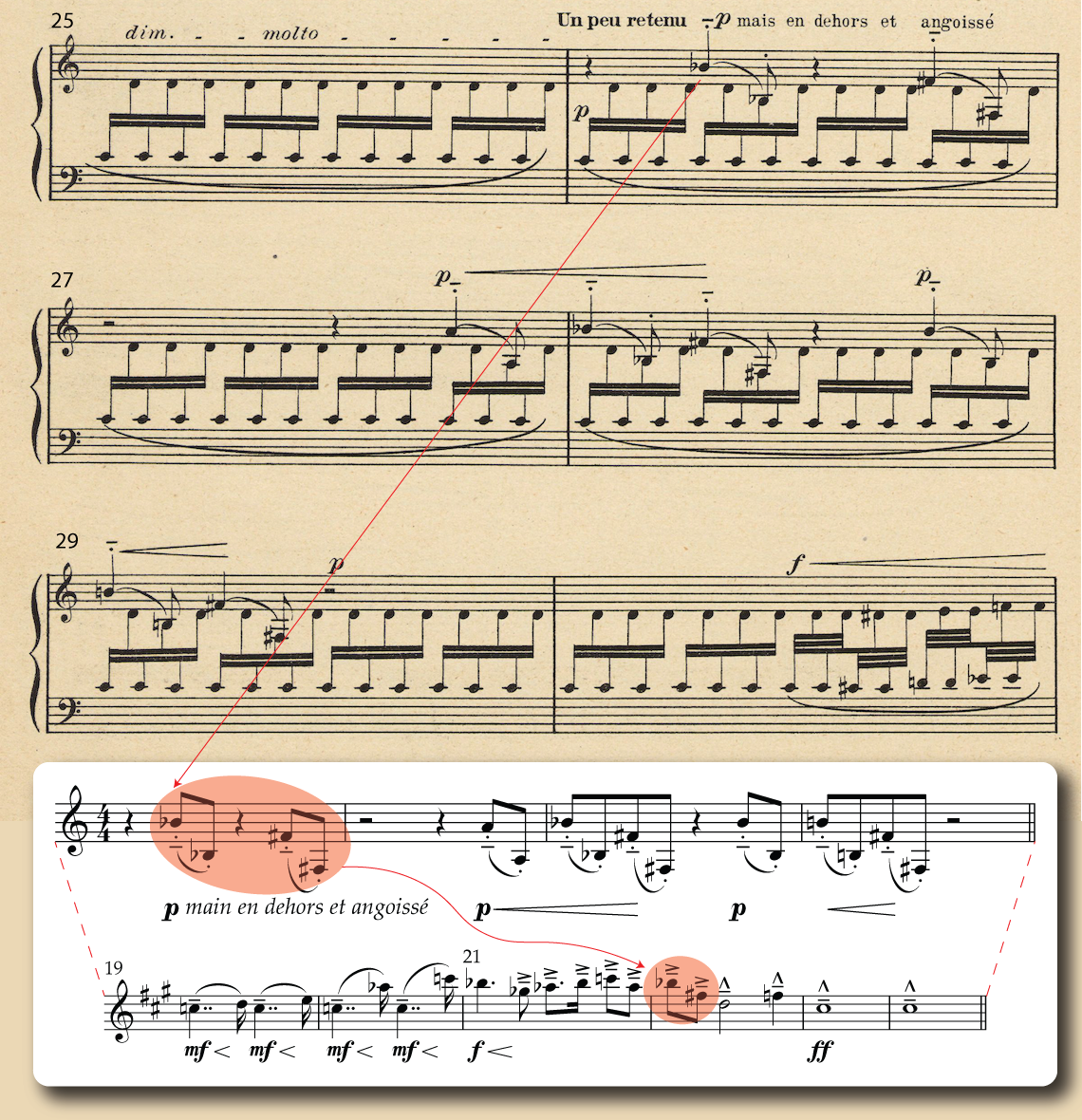
Paavali Jumppanen, piano
Isabella Stewart Gardner Museum
Creative Commons Attribution-NonCommercial-NoDerivs 4.0
The ostinato now uses the notes E - F# and follows the melodic development. At bar 33, an ascending chromatic movement begins. We return to the key signature of A major at bar 35:
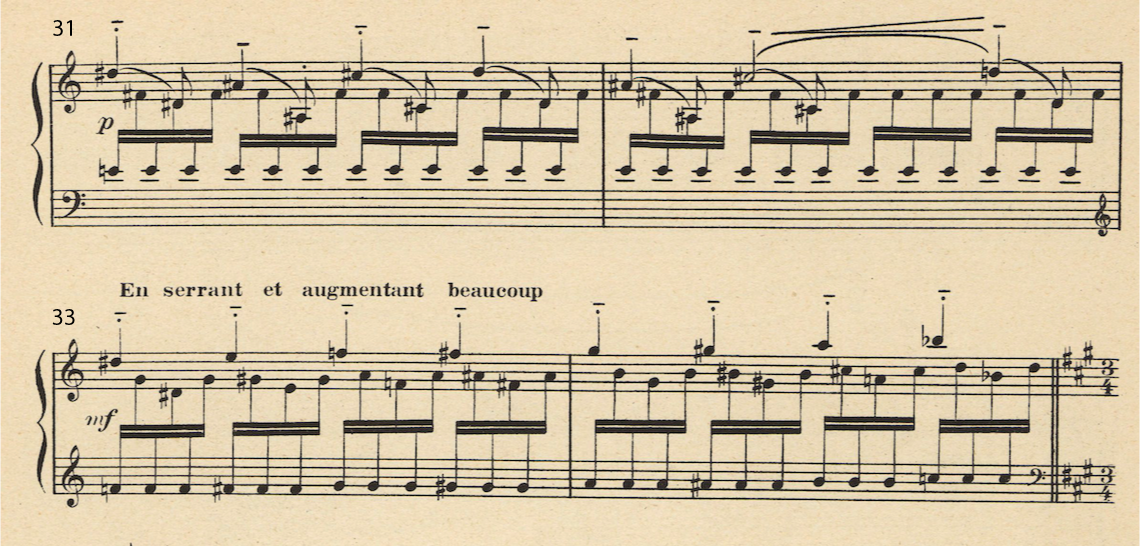
Paavali Jumppanen, piano
Isabella Stewart Gardner Museum
Creative Commons Attribution-NonCommercial-NoDerivs 4.0
Measures 35 to 37 use the hexatonic scale (B) despite the key signature of A major. The thematic material A, a variant of bars 10 to 14, develops as an internal voice between an upper C# pedal tone and a B pedal tone on the bass:
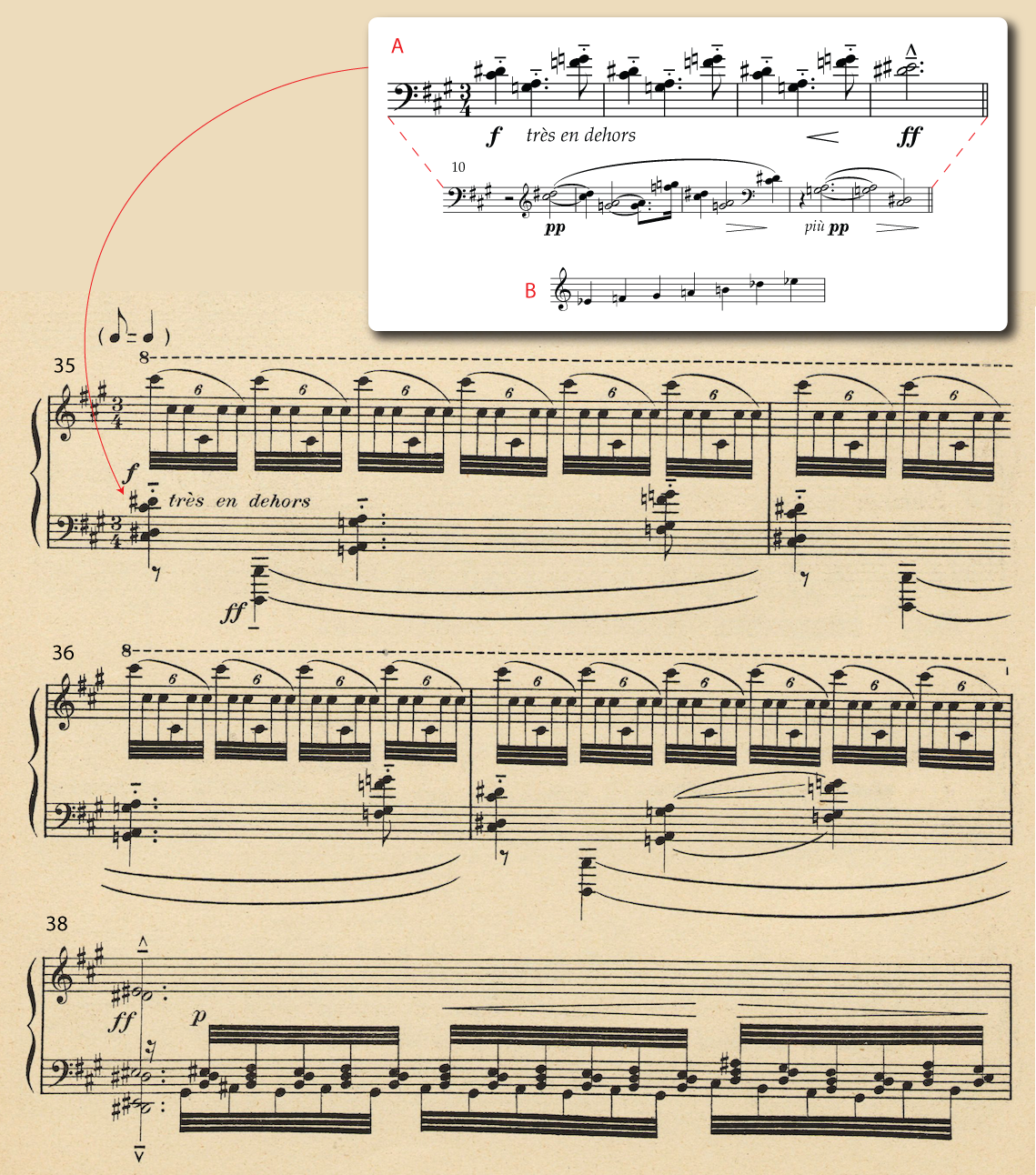
Paavali Jumppanen, piano
Isabella Stewart Gardner Museum
Creative Commons Attribution-NonCommercial-NoDerivs 4.0
At measure 38, the hexatonic scale is abandoned. We have rewritten the passage in a rhythmically correct way. Note that the notation used by Debussy is more straightforward despite not being precise.
- An internal D# pedal tone (A).
- The second motif that was previously used as ostinato reappears (B).
- We find it in the form of a minor second (C) in the chords' upper voice.
- At the end of the measure, the two voices expand their movement (D). Debussy will reuse this descending motif.
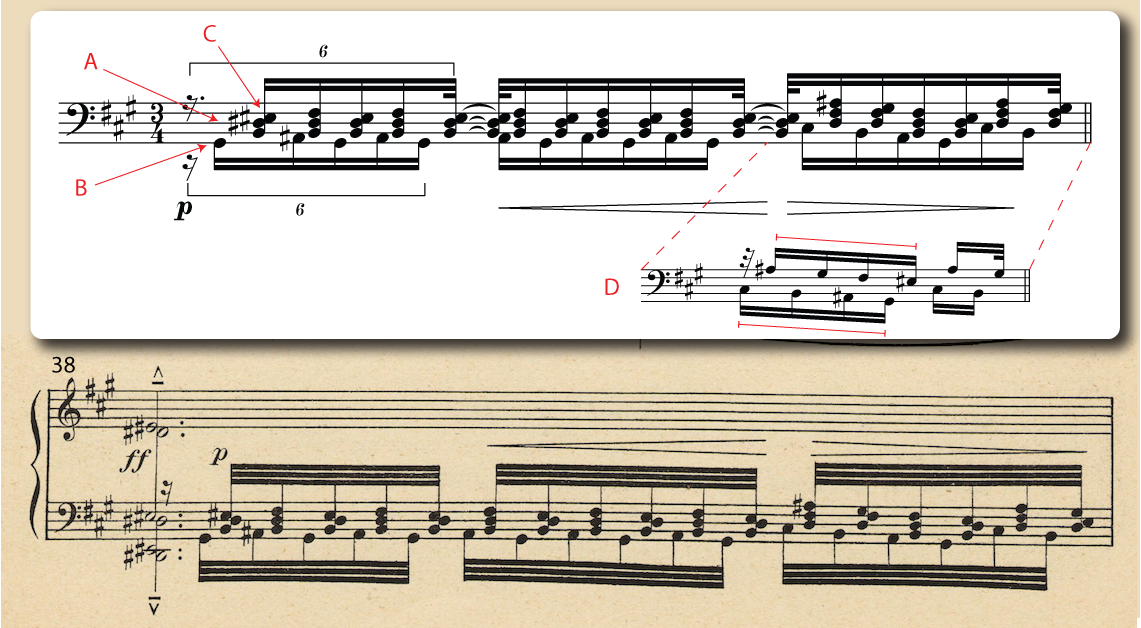
Measures 35 to 38 repeat in measures 39 to 42.
The previous bars' descending motif is developed over a D# minor chord with a minor ninth and flat thirteenth. At measure 46, a chromatic movement leads us to the next section:
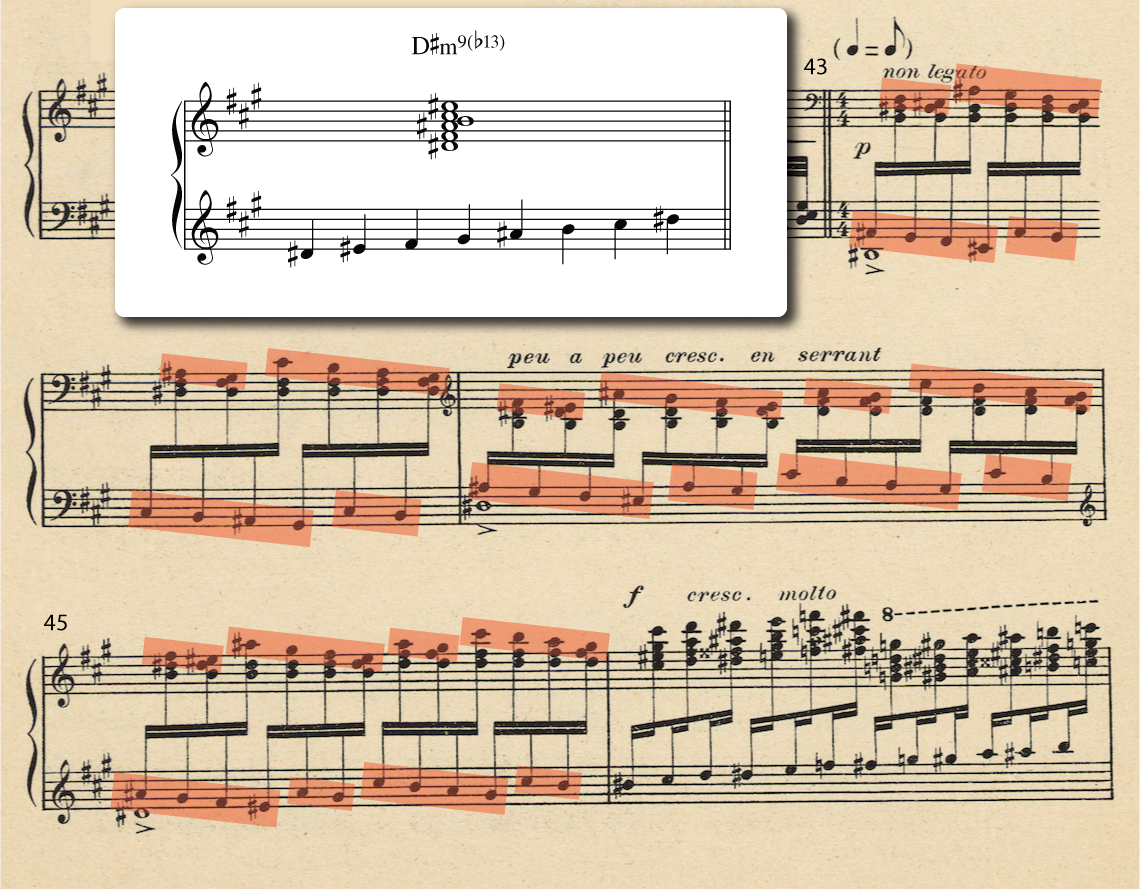
Paavali Jumppanen, piano
Isabella Stewart Gardner Museum
Creative Commons Attribution-NonCommercial-NoDerivs 4.0
Bars 47 to 53 are a variation of bars 21 to 24. Again the thematic material is doubled with dominant seventh chords. A D# pedal tone appears in measure 49.
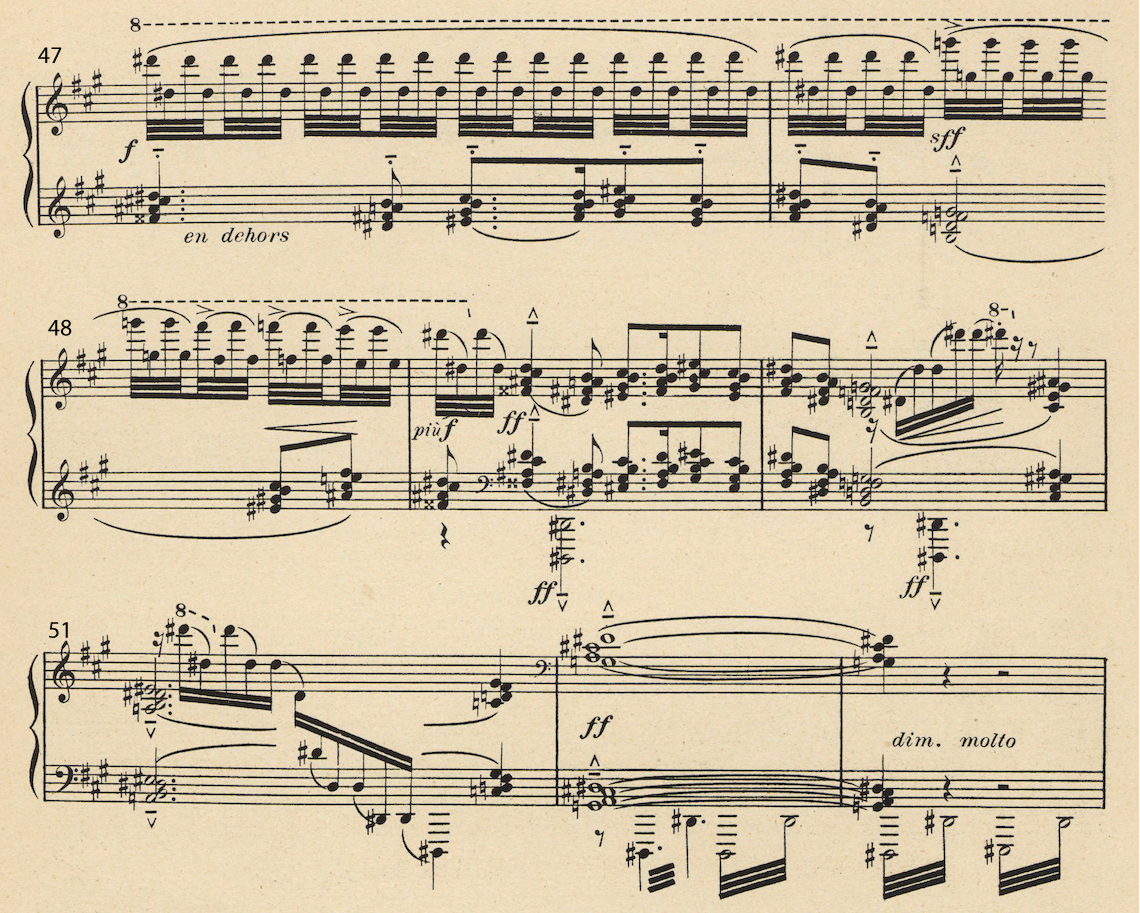
Paavali Jumppanen, piano
Isabella Stewart Gardner Museum
Creative Commons Attribution-NonCommercial-NoDerivs 4.0
Measures 54 to 56 are a variation of the section that begins at bar 25. In this case, the ostinato alternates between minor and major seconds. Thematic material now has grace notes added. Shorter rhythmic values add energy to the passage.
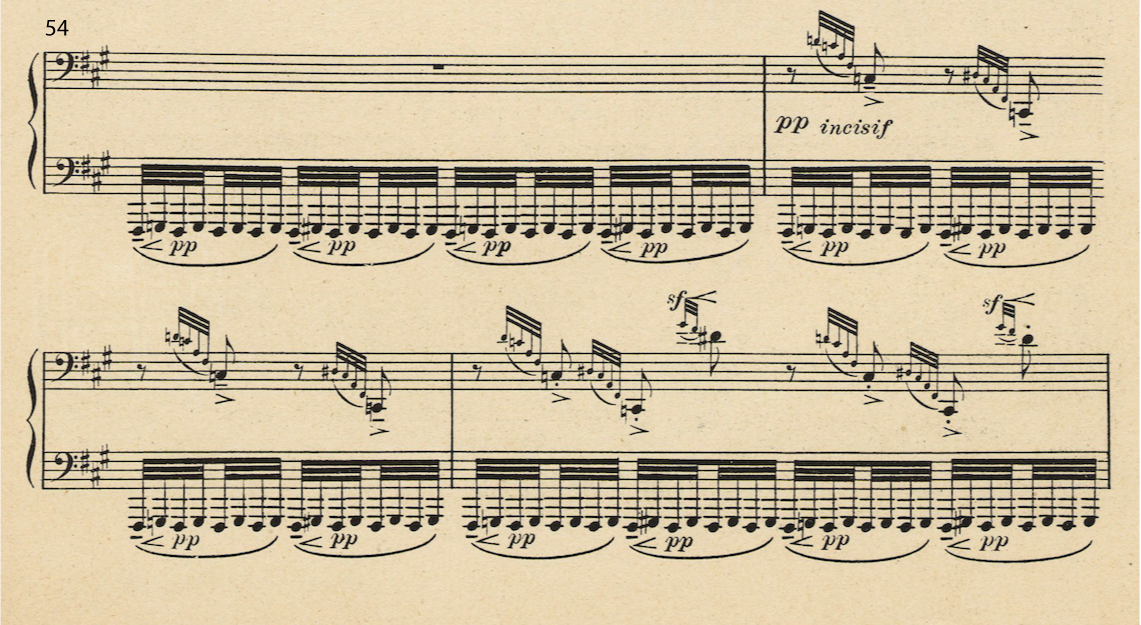
Paavali Jumppanen, piano
Isabella Stewart Gardner Museum
Creative Commons Attribution-NonCommercial-NoDerivs 4.0
A recapitulation begins at measure 57 with the arpeggio of the dominant D seventh and A flat dominant chords as in the first bars of the prelude:
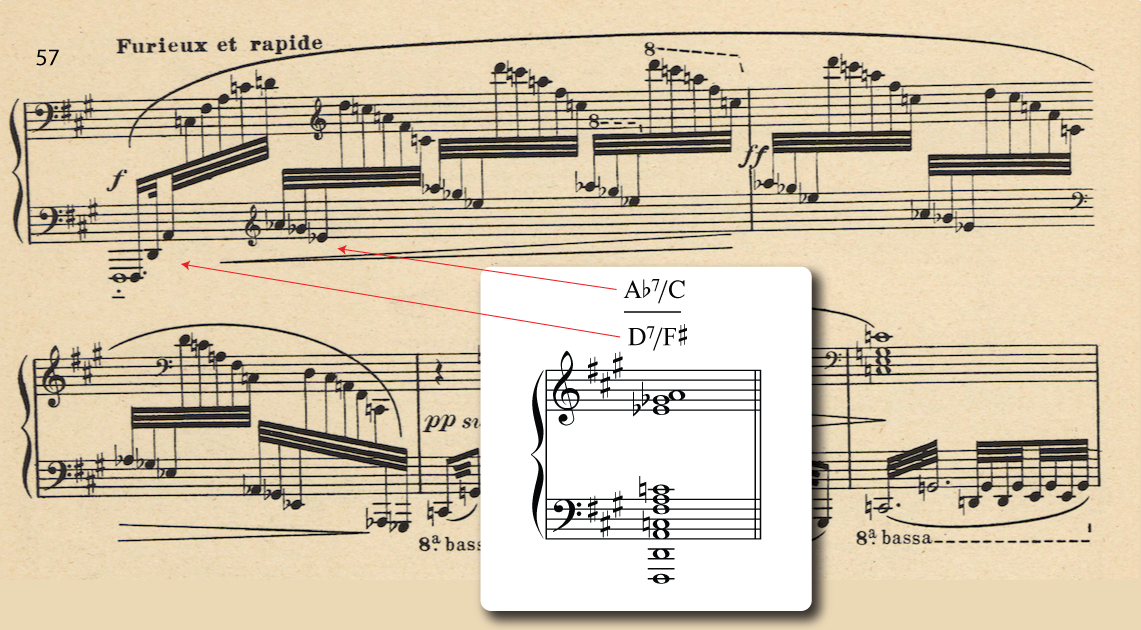
Paavali Jumppanen, piano
Isabella Stewart Gardner Museum
Creative Commons Attribution-NonCommercial-NoDerivs 4.0
Measures 59 to 62 are similar to measures 7 to 9. First transported an ascending augmented fourth and then at the original pitch (measure 62):

Paavali Jumppanen, piano
Isabella Stewart Gardner Museum
Creative Commons Attribution-NonCommercial-NoDerivs 4.0
The coda begins at bar 63 with final development of the thematic material.
- Using the Locrian #2 mode (VI mode of A melodic minor scale) in measures 63 to 68 (A).
- At measure 69, the hexatonic scale reappears (B).
- The prelude ends on an F # chord with sixth added (measures 70 and 71 (C).

Paavali Jumppanen, piano
Isabella Stewart Gardner Museum
Creative Commons Attribution-NonCommercial-NoDerivs 4.0
Complete Prelude
Paavali Jumppanen, piano
Isabella Stewart Gardner Museum
Creative Commons Attribution-NonCommercial-NoDerivs 4.0
© 2020 José Rodríguez Alvira. Published by teoria.com